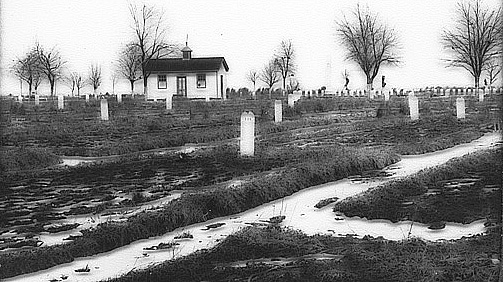To NYCHS:
XXX
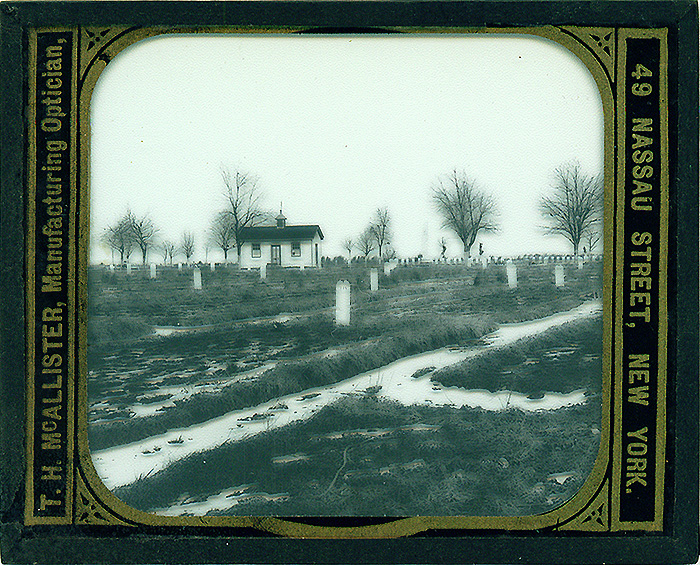
XXX
|
|
Above is an a color image of the second vintage Hart Island photo glass slide sent to NYCHS by Bob Ballatine. The whole slide is 4 inches by 3.25 inches. Click image to access larger version. Use your browser's "back" button to return.
|
|
I have for NYCHS another City Cemetery slide I obtained from Ebay. Apparently this Hart Island scene was one of a series of images in a lantern show presented many years ago in NYC. The photo was taken by a NYC firm and but they didn't date it. The place markers look wooden. I wonder what you and the visitors to your web site can come up with about this "second mystery glass slide of Potter's Field."
Among the Ebay offerings I keep watch for are any involving Hart Island history. I am interested in the island's history beause its long-time warden, Ed Dros, was a ham radio operator as am I . . . .
Bob Ballantine
W8SU Warren, Ohio
XXX
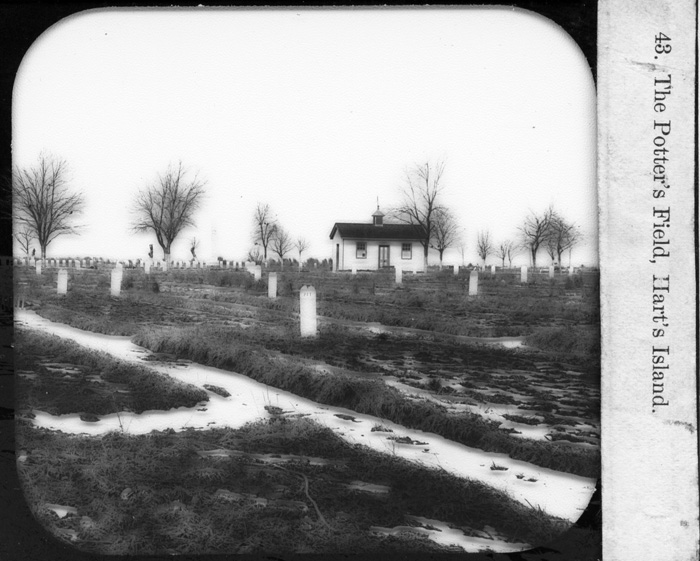
XXX
|
|
The reverse of the second vintage Hart Island photo glass slide sent to NYCHS by Bob Ballatine features, vertically on the right, its name and the ordinal for projection of its image in the lantern show's sequence. Click image to access a larger version. Use your browser's "back" button to return.
|
| To Bob Ballatine:
NYCHS again has cause to thank you for the generous gift of a "mystery glass slide of Hart Island." But this time we at least know who produced it. The company proclaimed its name and address in gold-color lettering on the glass slide. What we don't know is when it was manufactured.
We are especially appreciative because, under close examination of the slide, one can detect the individal makers for the separate graves of former soldiers and sailors buried in the Potter's Field's section set aside for Civil War Union veterans. An outline of their obelisk monument, erected in 1877 by the Grand Army of the Republic Reno Post No. 44, is discernable, but just barely. More about this aspect appears in image boxes further down the page.
XXX
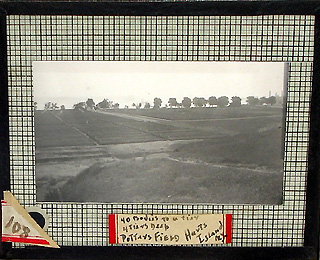
XXX
|
|
The first vintage Hart Island photo glass slide sent to NYCHS by Bob Ballatine. The actual photo portion of the glass slide is 3 inches wide by 1.75 inches. Click image to access NYCHS web page about it. Use your browser's "back" button to return.
|
|
Why Glass Slide?
Glass slides like the two you have given us were made for use in lantern shows, the late 19th Century/early 20th Century forerunner to today's digital media presentations. Glass was able to withstand the intense heat of the early projection light sources. We do know this was the 43rd slide in such a lantern show. What we don't know is the show's title or theme.
Could it have been a visual tour of New York, with social commentary on its sadder aspects? Quite possibly, even most probably.
Potter's Field -- where plain pine coffins of the unclaimed dead share crowded common burial trenches -- was seen by social reformers as symbolizing the fate of the poor who in life shared a pitiful existence in the crowded alleys and tenements of the city's slums.
XXX
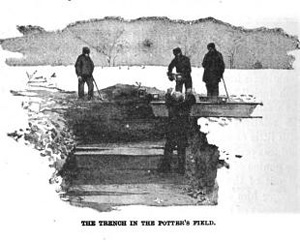
XXX
|
|
Above is an image of the Potter's Field illustration that appeared in the 1890 first edition of Jacob Riis' How the Other Half Lives. It was derived from one of the flash photos produced from his experiments on Hart Island. They helped launch his career as a photo-journalist/magic lantern lecturer.
Below is the Riis Hart Island photo from which the illustration was derived. Click it for a larger view. Note that in the larger view, the white memorial shaft and the individual grave markers near it in the cemetery's Civil War Union veterans burial section are clearly discernable in upper left area of the image. Use your browser's "back" button to return.
|
XXX
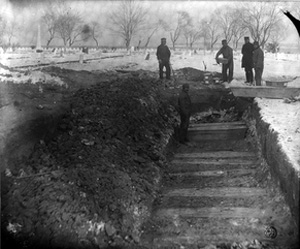
XXX
|
| Jacob Riis on Hart
One such reformer was Jacob Riis for whom a well-known beach park in the western Rockaways is named. He was a New York Tribune reporter whose crime news/police beat coverage involved his frequenting the city's worst precincts. He found words alone failed to convey the human derogation he encountered in the squalor that constituted work places and living quarters of the poor in mostly immigrant communities such as the Five Points neighborhood near the City Prison aka the Tombs.
Riis turned to photography to help tell that on-going horror story to better-off New Yorkers so they would be stirred to support programs and laws to improve housing and employment conditions. He experimented with a then newly-emerging technology -- flash photos -- to capture scenes which might move viewers emotionally even as his words might move them intellectually. He sought to have his audiences want something done to change what the pictures showed them and what the accompanying text or narration told them. Some of his first flash experiments took place in Potter's Field on Hart Island.
When he had a sufficient number of photos, Riis arranged them into what was called then a magic lantern show. Today we would call it a slide projection show if we bothered to work with actual film slides. More likely we would opt for digital images and call the show a media presentation.
Riis' first illustrated lecture -- entitled The Other Half: How It Lives and Dies in New York -- was given in January 1888 to his camera club. Later Riis illustrated lectures were presented to church gatherings, civic associations, do-good groups, fraternal societies and social organizations.
XXX
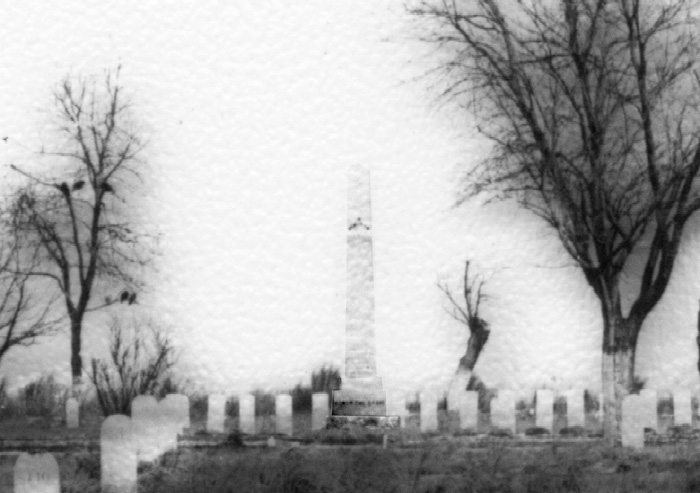
XXX
|
|
Enhancement and enlargement of a section of the second Hart Island glass slide sent NYCHS by Bob Ballantine makes more discernable the white memorial shaft and the individual grave markers near it in the cemetery's Civil War Union veterans burial section. Click image to access a larger view. Use your browser's "back" button to return.
|
| Other Half burials
Attending one of those shows was an editor of Scribner's Magazine who had Riis do a 20-page article entitled How the Other Half Lives for the Christmas 1889 issues. It consisted of text written by Riis and woodcut illustrations based on about 20 Riis photos. Mass print production (broadsides, newspapers, magazines, etc.) technology at that point in its development had not achieve capacity to deliver photos to readers.
In 1890 Riis and Charles Scribner's Sons expanded the material into a full-length book with more than 40 illustrations, including one entitled The Trench in The Potter's Field.
The trench illustration was positioned at the end of Chapter XIV -- The Common Herd after its concluding sentences:
One free excursion awaits young and old whom bitter poverty has denied the poor privilege of the choice of the home in death they were denied in life, the ride up the Sound to the Potter's Field, charitably styled the City Cemetery.
XXX

XXX
|
|
Only the obelisk, a low stone wall and low iron rail fencing now mark where the individual graves of Civil War Union veterans once were. Their remains were removed and reburied in other cemeteries. For more information, access Hart Island Potter's Field Former Graveyard for Civil War Vets elsewhere on this web site by clicking the above image, extracted from a circa 1967 photo. Use your browser's "back" button to return.
|
| But even there they do not escape their fate. In the common trench of the Poor Burying Ground they lie packed three stories deep, shoulder to shoulder, crowded in death as they were in life, to "save space;" for even on that desert island the ground is not for the exclusive possession of those who cannot afford to pay for it.
There is an odd coincidence in this, that year by year the lives that are begun in the gutter, the little nameless waifs whom the police pick up and the city adopts as its wards, are balanced by the even more forlorn lives that are ended in the river.
I do not know how or why it happens, or that it is more than a mere coincidence. But there it is. Year by year the balance is struck—a few more, a few less —substantially the same when the record is closed.
Lights & Shadows
Eighteen years before publication of Riis' How the Other Half Lives, a book was published that touched upon many of the same seamier sides of day-to-day New York. It succeeded in making enough of an impression on the public mind that it -- or at least parts of its title and its general conception -- eventually evolved into a popular lantern show.
The 1872 book's title page features such delicious 19th Century run-on sentences that its wonderful wording is presented here in all its self-promotional splendor and grandiose capitalization:
LIGHTS AND SHADOWS
OF NEW YORK LIFE;
OR, THE
SIGHTS AND SENSATIONS
OF
THE GREAT CITY.
A WORK DESCRIPTIVE OF THE
CITY OF NEW YORK IN ALL ITS VARIOUS PHASES;
WITH FULL AND GRAPHIC ACCOUNTS OF
Its Splendors. And Wretchedness; Its High And Low Life; Its Marble Palaces And Dark Dens; Its Attractions And Dangers; Its Rings And Frauds; Its Leading Men And Politicians; Its Adventurers; Its Charities; Its Mysteries, And Its Crimes.
By JAMES D. McCABE,
Author of "Paris by Daylight and Gaslight," "History of the War Between Germany and France," "Great Fortunes," "The Great Republic," Etc., Etc.
ILLUSTRATED WITH NUMEROUS FINE ENGRAVINGS OF NOTED PLACES, LIFE AND SCENES IN NEW YORK.
by subscription only, and not for sale in the book stores.
PUBLISHED BY
THE NATIONAL PUBLISHING CO.,
PHILADELPHIA, Pa.; CHICAGO, ILL.; ST. LOUIS, Mo.
XXX

XXX
|
|
Note how Potter's Field is included in the "Synopsis" list of sights advertized in the above image of a 19th Century billboard promoting a magic lantern show entitled "LIGHTS AND SHADOWS OF A GREAT CITY."
|
| The book mentioned in passing a few former Potter's Field sites on Manhattan Island as well as the current one on Hart but did not devote any extended passages to Potter's Field operations as such. However, its Chapter LXXXIV focused on the city morgue that figured significantly in the story of City Cemetery, as the following paragraphs from its opening made clear:
There stands on the shore of the East River, at the foot of Twenty-sixth street, a massive gray-stone building, known as Bellevue Hospital [conducted by the Commissioners of Charity and Correction]. Over the lowest door of the front, on the upper side of Twenty-sixth street, is a single word in gilt letters—MORGUE. This door marks the entrance to the Dead House of New York, one of the most repulsive, but most terribly fascinating places in the city. The place is named after the famous dead house of Paris, and the interior is arranged in exact imitation of it, except that it is smaller.
It is a gloomylooking place, this Morgue, and it is always crowded. Bodies found in the streets or in the harbor are brought here for identification. They are kept a certain length of time, usually from twenty-four to forty-eight hours, and if not claimed by relatives or friends, are buried at the expense of the city.
Every article of clothing, every trinket, or other means of identification, found with a body, is carefully preserved, in the hope that it may lead to a discovery of the cause of the death.
The room is gloomy and cell-like in appearance. It is about twenty feet square. The floor is of brick tiles, and the walls are rough and heavy.
The apartment is divided into two unequal portions by a partition of glass and iron. The smaller portion is used by the public. The remainder is devoted to the purposes of the establishment.
Back of the glass screen are four stone tables on iron frames, each with its foot towards the glass. Stretched on these are lifeless naked forms, each covered with a sheet.
A stream of cold water, from a movable jet, falls over the lifeless face of each and trickles over the senseless forms, warding off decay until the last moment, in the hope that some one to whom the dead man or woman was dear in life will come and claim the body. A vain hope, generally, for but few bodies are claimed. Nearly all go to the potter's field.
The McAllister brand
The name in gold color lettering on the lantern show glass slide rates mention as belonging to an American family who became a national leader in the business of optics during the 19th Century -- inventing, manufacturing and marketing all sorts of vision-related devices for scientific, entertainment, commercial and personal uses. These included but were not limited to microscopes, stereopticons, dissolving lanterns and magic lanterns as well as the views to use with such equipment.
XXX
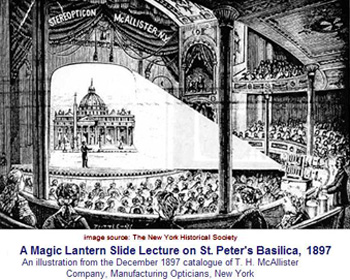
XXX
|
|
The above image is derived from a screen capture of part of Magic Lanterns & Slides, Chapter 5 of Sweet Briar College Prof. Christopher L.C.E. Witcombe's web lecture pages on Art History and Technology. Click image to access it. Use your browser's "back" button to return.
|
| Thomas H. McAllister's grandfather, John, and a partner began a whips and canes business on Chestnut St. circa 1798 in old Philadelphia and later added eyeglasses and other optical articles to their stock.This side of the their trade proved so successful, they dropped their original lines of merchandise and concentrated on manufacturing and selling mathematical and optical instruments as well as spectacles, making it the first such shop in America. After his partner retired, John McAllister and son John Jr. continued the business as John McAllister & Son.
John Jr. continued the firm after the death of John Sr. Incidentally John Jr. is credited with having devised in 1858 the street and house numbering system of blocks of one hundred with odds and evens being on opposite sides, first adopted by Philadelphia and eventually copied around the U.S. and much of the world.
XXX
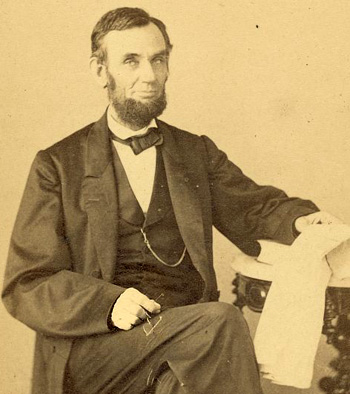
XXX
|
|
President Abraham Lincoln is said to have worn McAllister-made spectacles. In this Library of Congress image, he holds a pair of eyeglasses.
|
| Eventually, John Junior's sons, Thomas Hamilton and William Young, took over and carried on the family business under the name McAllister & Brother. In 1865, Thomas H. moved to New York City and set up his own independent firm on Nassau St.Both brothers continued separately in the same line of trade but in different cities as their respective home bases. Both were highly regarded within their profession but Thomas H. seems to have reached a wider, more general audience. The latter's widely advertised lines of popular stereoscopic and lantern show views suitable for home or social club gatherings may have been a factor. T. H. died at home 227 Degraw St., Brooklyn, Nov. 29, 1898 at age 75 but the firm with his name continued for number of decades of the 20th Century, first under his son, Caldwell W., and then under the executrix of Caldwell's estate, Lillian A. McAllister.
As you can see from the foregoing information, a considerable amount of history connects with your kind gift. Thank you for sending NYCHS this second glass slide, thus prompting us to track down those historical connections.
NYCHS webmaster
| 
